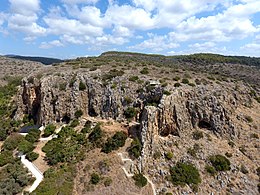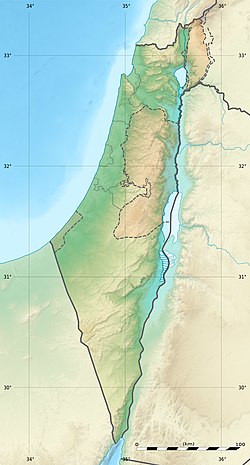
KNOWPIA
WELCOME TO KNOWPIA
Summary
The Caves of Nahal Me’arot / Wadi el-Mughara ("Caves Creek"), named here by the Hebrew and Arabic name of the valley where they are located, are a UNESCO Site of Human Evolution in the Carmel mountain range near Haifa in northern Israel.[1][2]
| UNESCO World Heritage Site | |
|---|---|
 | |
| Official name | Sites of Human Evolution at Mount Carmel: The Nahal Me’arot / Wadi el‑Mughara Caves |
| Location | Mount Carmel, Israel |
| Criteria | Cultural: (iii), (v) |
| Reference | 1393 |
| Inscription | 2012 (36th Session) |
| Area | 54 ha (130 acres) |
| Buffer zone | 370 ha (910 acres) |
| Coordinates | 32°40′12″N 34°57′55″E / 32.67000°N 34.96528°E |
 Location of Nahal Me'arot Nature Reserve in Near East  Nahal Me'arot Nature Reserve (West and Central Asia)  Nahal Me'arot Nature Reserve (Israel) | |
The four UNESCO-listed caves are:
- Tabun or Tanur cave (lit.: "Oven")
- Gamal or el-Jamal cave ("Camel")
- El Wad or Nahal cave ("Stream")
- Skhul or Gedi cave ("Kid")
The four caves were proclaimed a site of "outstanding universal value" by UNESCO[1] in 2012. They are protected within a nature reserve.[2]
The caves were used for habitation by hominins and prehistoric humans and contain unique evidence of very early burials, at the archaeological site of el-Wad cave in the Nahal Me'arot Nature Reserve.
Gallery edit
-
A Paleolithic reconstitution in Jamal Cave
-
Paleolithic tools in Jamal Cave (replica)
-
Entrance to el‑Wad Cave
-
Inside el‑Wad Cave
-
Excavation work in el‑Wad Cave's terrace
-
El‑Wad point microlith
-
-
See also edit
References edit
External links edit
Wikimedia Commons has media related to Nahal Mearot.
- Official page at Israel Nature and Parks Authority website
- UNESCO: Sites of Human Evolution at Mount Carmel: The Nahal Me’arot / Wadi el-Mughara Caves
- Nahal Me'arot recognized as World Heritage Site


